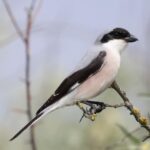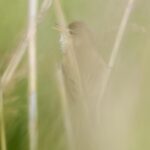Day 2 of a three day long weekend of Spring Migration tours. We met again in Wells and today we set off in the other direction, to the west. It was forecast to rain, at least for this morning and possibly most of the afternoon too, so we headed for Titchwell where at least we could get out of the weather in the hides.
The car park at Titchwell was unusually quiet for a weekend, with the weather clearly putting people off. It meant we had a chance to look round the bushes in the overflow car park before it got busy, but there was not much to be seen here today in the rain – the birds had decided to stay at home too! A Willow Warbler was singing from the trees, and a Chiffchaff was doing the same. A Cetti’s Warbler shouted its song at us from deep in the undergrowth.
The feeders by the visitor centre were also rather quiet – apart from a few Chaffinches and tits. A male Pheasant stood on the pallets underneath, looking decidedly wet and miserable.
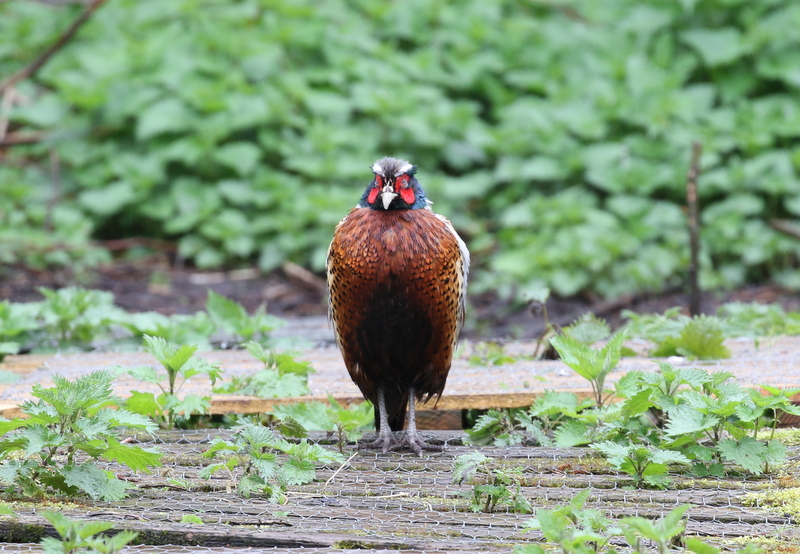 Pheasant – standing under the feeders in the rain
Pheasant – standing under the feeders in the rain
The ditch where the Water Rail has been all winter was rather full with dirty rainwater, run off the fields and paths. Still, we found the Water Rail a little bit further along, feeding up on an exposed area of mud and rotting leaves. It was hard to get onto it at first, but eventually everyone was treated to great views of it. We had walked a little further along when we heard a Water Rail squealing from the ditch back behind us. We assumed it was the one we had just been watching at first, but turned round to see it was a second Water Rail running away from us with its undertail coverts puffed out.
Having seen the pair of Water Rails mating here a couple of weeks ago, we had an idea what might be coming next. We could only just see the pair today, as they were a way back along the ditch and mostly hidden by overhanging branches. For something which is seen so rarely, we were extraordinarily lucky to see Water Rails mating here a second time!
 Water Rail – here is one of them from a few weeks ago
Water Rail – here is one of them from a few weeks ago
A quick scan of the dried up grazing meadow ‘pool’ on the way past revealed nothing more than a lot of Black-headed and Common Gulls. It was exposed to the elements out on the mud – and up on the seawall! We continued on and had a look at the reedbed pool next. Two smart drake Red-crested Pochard were out in the middle and a few Common Pochard were down at the front. A pair of Marsh Harriers came up out of the reeds and circled low a couple of times before dropping back in.
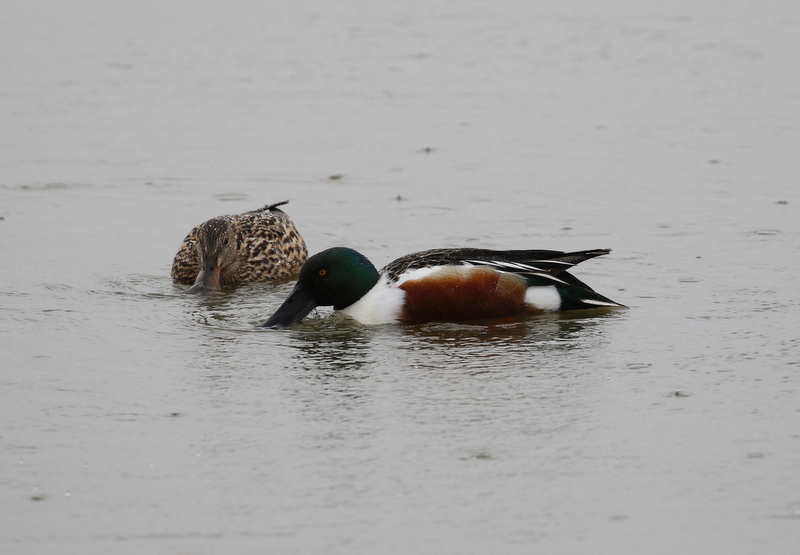 Shoveler – feeding with their heads down in the water
Shoveler – feeding with their heads down in the water
Island Hide provided some welcome respite from the rain, although it was thankfully not raining hard. The water level on the freshmarsh is still quite high, and presumably topped up again by all the rain overnight. Most of the hordes of ducks which spent the winter here have now departed, but there were still a few Teal remaining, plus several Shoveler and Gadwall.
 Teal – there are still a few around the reserve still
Teal – there are still a few around the reserve still
There were not so many waders on here today. A small number of Black-tailed Godwits, resplendent in their rusty summer plumage, were mostly sleeping on the islands or on the edge of a larger roosting flock of Oystercatchers. A single Dunlin flew round and landed briefly, just long enough for us to get it in the scope and admire its summer black belly patch which was starting to appear. There were a few pairs of Avocet on here, but not as many as there might normally be.
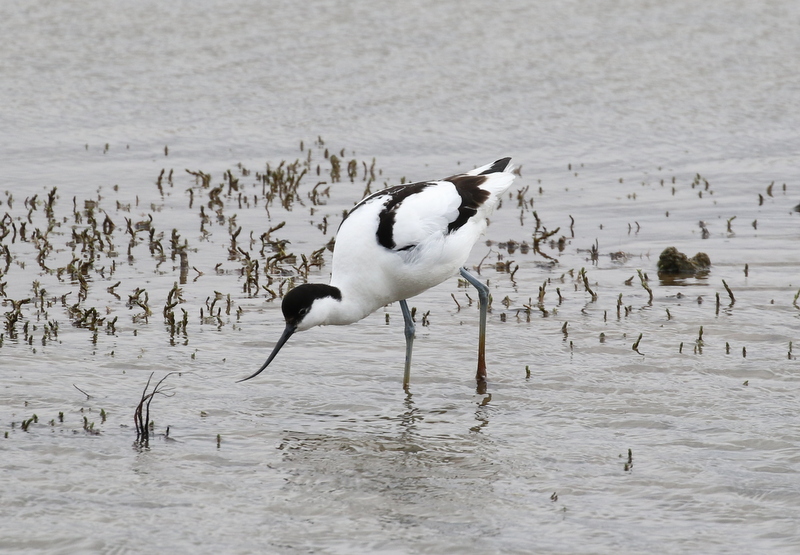 Avocet – not as many as normal around the reserve today
Avocet – not as many as normal around the reserve today
A lone Ringed Plover was on one of the islands but was distant from over this side. We got a better view of it from round at Parrinder Hide – noting its black-tipped orange bill and lack of a golden eye-ring. There had apparently been some Little Ringed Plovers here as well before we arrived, but they appeared to have flown off. A single Common Snipe was feeding on the bank beyond the hide and a Turnstone was hiding in the vegetation on the newly fenced off island.
 Ringed Plover – just one, on one of the islands on the freshmarsh
Ringed Plover – just one, on one of the islands on the freshmarsh
There were quite a few Pied Wagtails around the islands, and we found at least one White Wagtail in with them too. The continental race to the British Pied Wagtail, it could be immediately picked out by its much paler silvery-grey back. White Wagtails are regular early migrants here, stopping off on their way back to Europe or Iceland. We were to see a few of them around the reserve today.
A big flock of Brent Geese flew in from the saltmarsh to bathe and preen. While we were looking at them, one of the group spotted a tern which dropped in to one of the small islands over the other side. Through the scope, we could see that it was a Common Tern, sporting a black-tipped red bill, another returning migrant and the first we have seen here this year. It rested on the island for a few minutes, before flying off again.
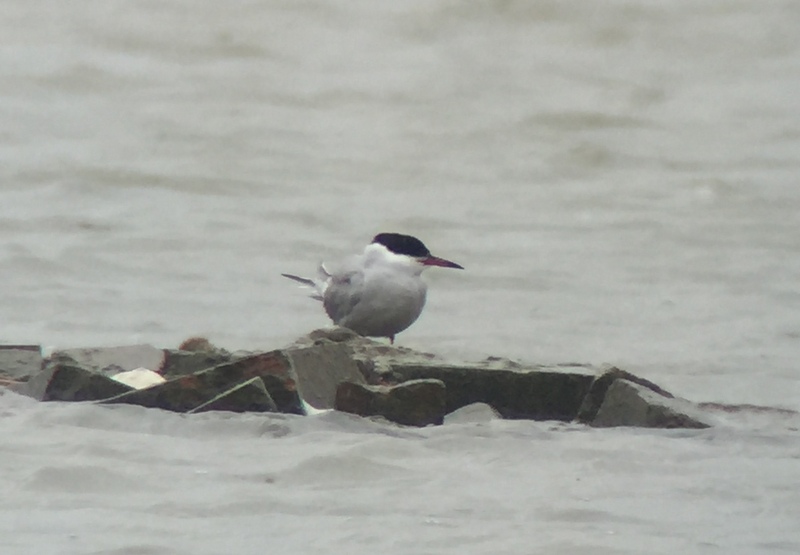 Common Tern – dropped into the freshmarsh for a few minutes
Common Tern – dropped into the freshmarsh for a few minutes
Volunteer Marsh was disappointingly quiet, apart from a few Redshank. The rain had eased to just a little light spitting and, looking to the north, the sky appeared to be brightening a little so we decided to brave the conditions and walk out further along the main path towards the beach.
There didn’t seem to be much on the Tidal Pools to look at either at first, but a careful scan revealed a single Little Ringed Plover on a strip of sandy island. Through the scope we could see its finer, dark bill and golden eye-ring, both of which immediately set it apart from the Ringed Plover we had seen earlier. A flock of small waders flew in from the direction of the sea and whirled round over the water before landing on a small island – a mixture of Dunlin and Turnstone.
We surprised ourselves by making it out to the beach and the weather was not as bad out here as we thought it might be. The tide was coming in, but there were still a few Bar-tailed Godwits and Grey Plover on the beach. A group of about a dozen Sanderling flew in along the beach and landed out on the sand in front of us – silvery grey above and sparkling white below, they were about the same size but much paler than the Dunlin we had just seen.
The sea was quite rough in the blustery north-west wind, but we could just make out a small raft of Common Scoter not too far ofshore. We were just trying to all get onto them when several hundred more Common Scoter flew in from further out to sea and circled round in front of us, before dropping down with the others. A single Fulmar was trying to battle past into the wind. We didn’t stay long out here today. Having racked up a few good species for the day, we beat a hasty retreat.
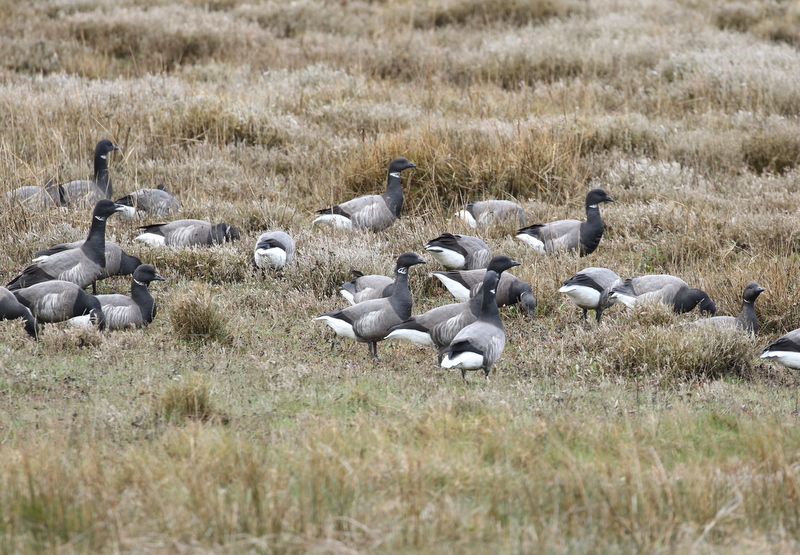 Brent Geese – back out on the saltmarsh, on the way back
Brent Geese – back out on the saltmarsh, on the way back
The weather continued to improve as we walked back and a few more birds started to appear as a consequence. On the Volunteer Marsh, a couple of Curlew were now in with all the Redshank along the tidal channel and a careful scan revealed two Knot as well, remarkably well camouflaged against the grey of the mud.
When we got to the reedbed, we could hear a couple of Sedge Warblers singing, but they were keeping uncharacteristically well hidden today. We got a couple of quick views of one of them in flight. A Cetti’s Warbler was more typically shouting at us from deep in the bushes. While we were trying to see the Sedge Warblers, we heard a couple of ‘pings’ behind us and turned round just in time to see two Bearded Tits zoom across the top of the reeds before dropping back down out of view.
We could even see a bit of blue sky now, so we stopped by the grazing meadow ‘pool’ again for a proper scan. A Bittern started booming from out in the reeds behind us. A couple of Whimbrel flew across in front of us, calling, and landed out on the saltmarsh. Another Little Ringed Plover was now out on the mud and another White Wagtail appeared from behind the reeds right down at the front.
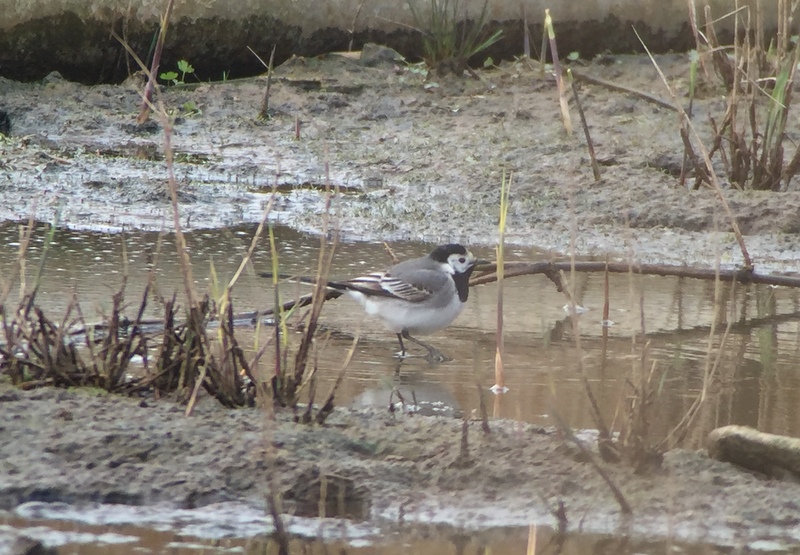 White Wagtail – we saw several around the reserve today
White Wagtail – we saw several around the reserve today
We were just about to leave when we spotted a small bird tucked into the edge of the reeds at the back, preening. There have been a few Water Pipits on here on and off throughout the winter, so it was good to see one still here and now sporting a lovely pink flush across the breast as it moults into summer plumage.
While we were watching the Water Pipit, a Grasshopper Warbler started reeling from the brambles out on the grazing marsh beyond. It gave several bursts of its distinctive clicking ‘song’ but we couldn’t see it from here, so we walked back a short way to have a look for it from a different angle. Unfortunately then it shut up and we didn’t hear it again.
We took a detour round along the Meadow Trail. There were several Chiffchaffs and Willow Warblers singing from the sallows. A male Blackcap dropped down into a small bush by one of the pools. A quick look in at Patsy’s Reedbed added Little Grebe to the day’s list and several Martins hawking for insects over the pool. We could see both plain brown-backed Sand Martins and black-backed House Martins which flashed their square white rump patches as they swooped down over the water. Yet another White Wagtail was feeding quietly along the edge.
Back at the Visitor Centre, we stopped for a well-earned hot drink. There were a few more birds around the feeders, but still just a selection of Chaffinches, Goldfinches, a Greenfinch and several tits (the Bramblings have not been seen for a couple of days, so may finally have moved on). While we were looking, a pair of Mediterranean Gulls circled overhead calling.
After lunch, we made our way up to Choseley. Some Ring Ouzels had just been reported in the fields here and it took no time at all to find them. An upland version of the Blackbird, the main difference is a bold, pale crescent on the upper breast (white in males, dirty off white in females). We could see three Ring Ouzels here, feeding on the short grass and bare ground around the edge of a field. The biggest problem now was heat haze, given that the sun was shining and the sky was blue! The weather had been forecast to improve this afternoon, but this was not what we had expected.
 Ring Ouzel – two of the three at Choseley this afternoon
Ring Ouzel – two of the three at Choseley this afternoon
The fields here are always full of Brown Hares. There was some half-hearted boxing from some of them today, although it didn’t seem like their hearts were really in it. Even so, they are great to watch. Three Stock Doves were also feeding on one of the tilled fields.
We finished the day over at Snettisham. The Ring Ouzels along Beach Road here have not been reported for a couple of days, but a quick scan from the car revealed at least one still in the paddocks. As we had already seen the ones at Choseley, we decided not to stop and to make the most of the weather with a walk round the Coastal Park.
The Coastal Park is always good for warblers, and we could hear several different species as we walked out along the path – a Lesser Whitethroat, several Willow Warblers and Chiffchaffs, a Sedge Warbler and a Cetti’s Warbler or two. Three Swallows zoomed past low over the bushes.
Out in the open grassy area by the seawall, three Wheatears flew up towards us as several dogs approached. The Wheatears perched nervously on the top of the larger hawthorns or smaller bushes for a few minutes until the danger had passed, before dropping down again onto the grass right in front of us. We had great views of them here.
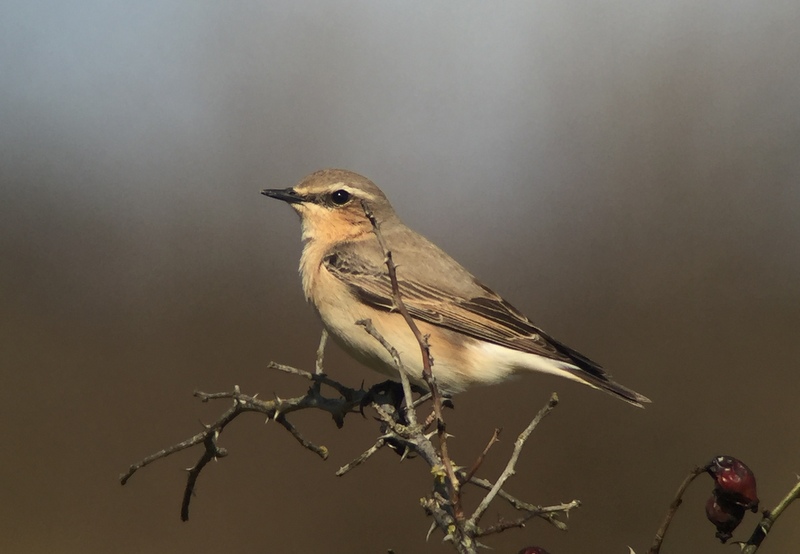 Wheatear – the female lacks the black bandit mask…
Wheatear – the female lacks the black bandit mask…
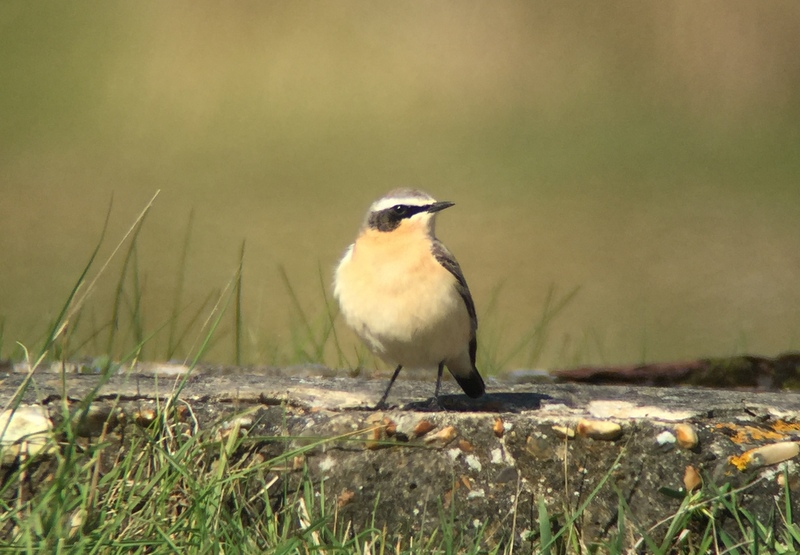 Wheatear – …which the male shows
Wheatear – …which the male shows
From up on the seawall, the tide was in, covering all the mud out on the Wash. We could also see some very black clouds out on the horizon, over the Lincolnshire coast. We weren’t quite sure whether they would head our way, so we kept a close eye on them as we walked north. There were lots of little flocks of Linnets on the seawall, with several smart males singing from the bushes.
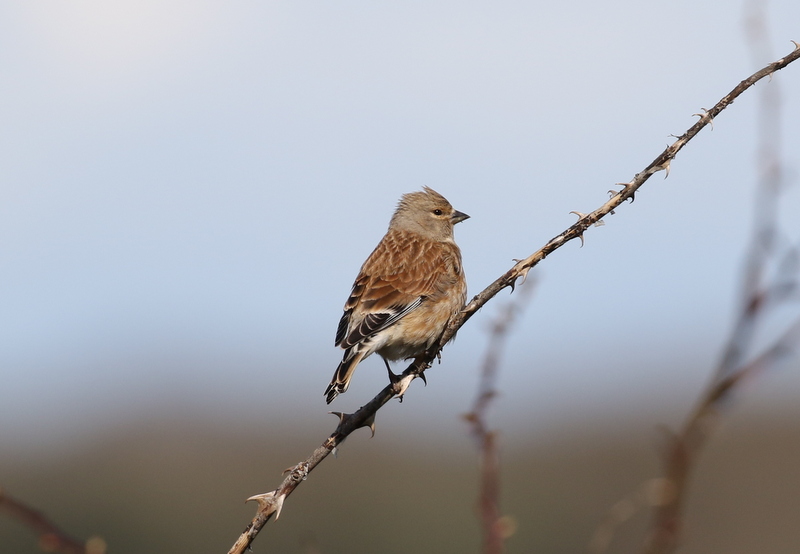 Linnet – singing from the brambles along the seawall
Linnet – singing from the brambles along the seawall
It gradually became clearer that the rain was heading straight for us. As it clouded over again, the birds went quiet once more. We cut across to the inner seawall and started to beat a retreat. There were lots of Greylag Geese out on the grazing marshes but on our way back we spotted a darker head sticking out of a thick patch of rushes. Through the scope we could confirm it was a Pink-footed Goose – we could also see the smaller and mostly dark bill with a pink band around it. We were just having a good look at it, when something spooked all the gulls, ducks and geese and four Pink-footed Geese flew up from where we had been watching. They circled round in front of us, giving us a nice flypast.
Then it started to rain, with a bit of hail mixed in for good measure. Thankfully it was not heavy and was at our backs as we walked. It didn’t take us long to get back to the car and it was pretty much time to call it a day anyway by then. We drove back through some heavier, wintry showers and were glad to be in the warm. Despite the weather, we had managed to see a great selection of birds and, when we added it up later, over 90 different species for the day!
